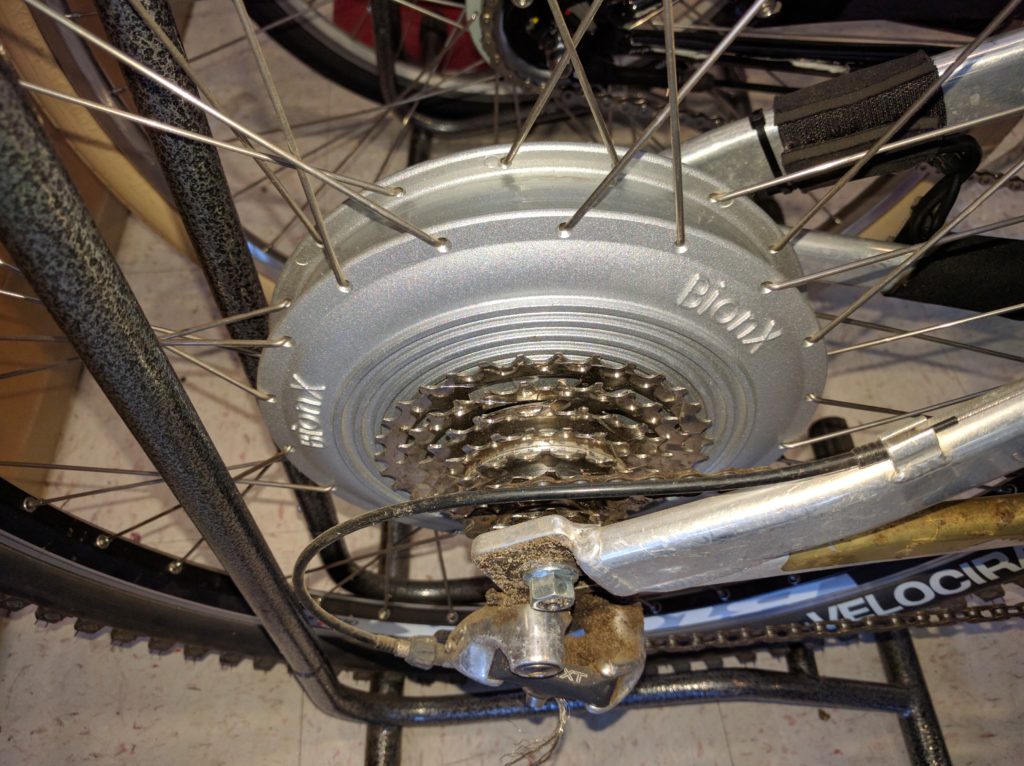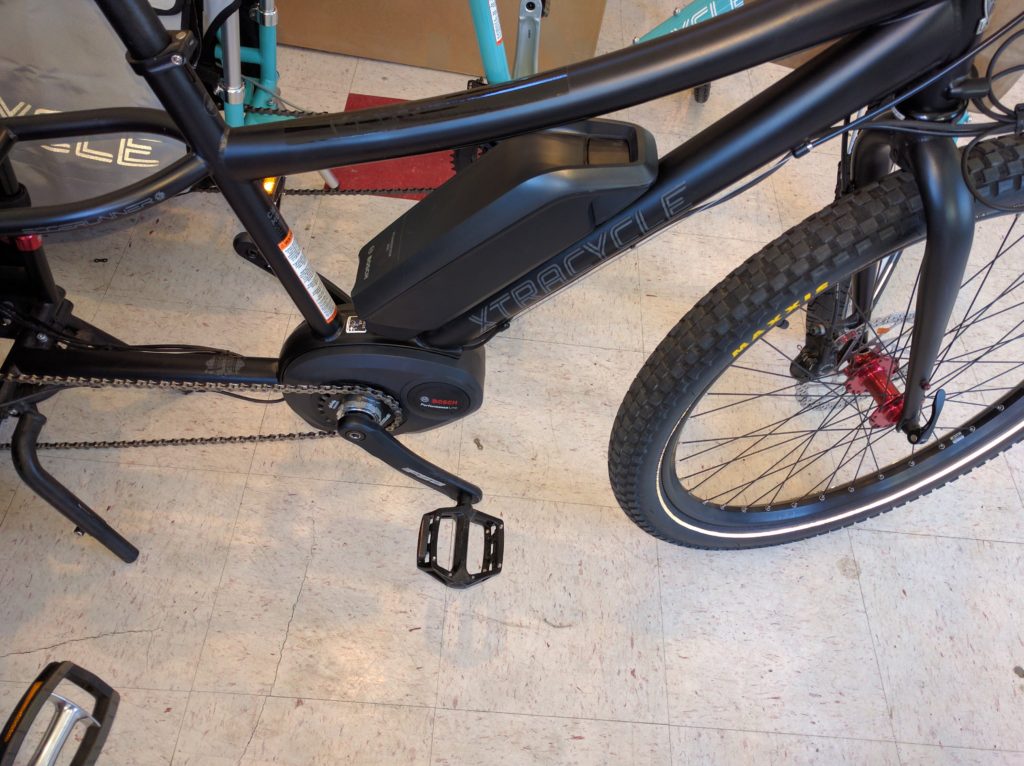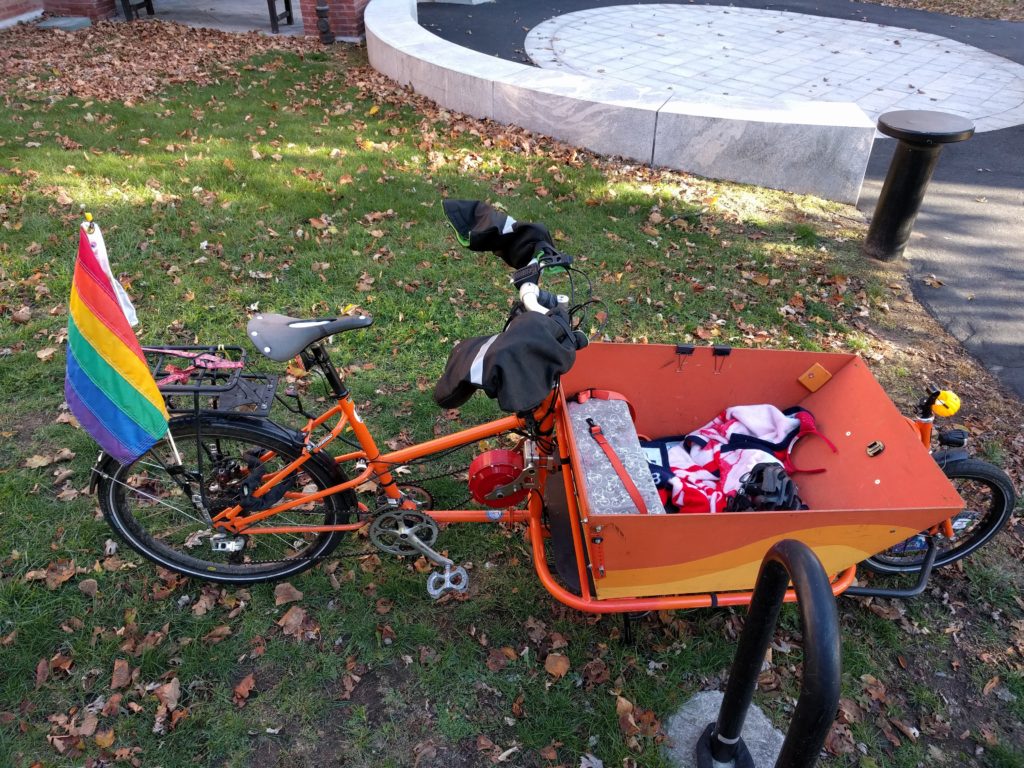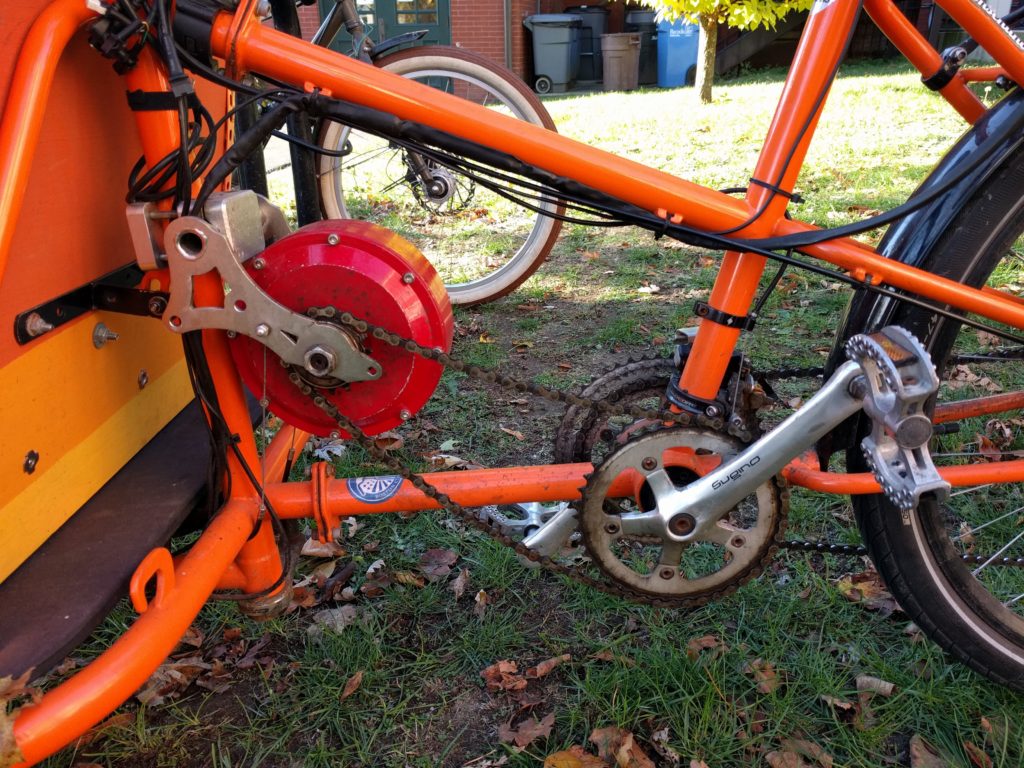Power to the Pedal
by David Chase
If you’d like to bike more but are put off by hills, a relatively long commute, or the need to combine children or other cargo with a long or hilly commute, you might consider an e-bike—a bicycle with a battery-powered electric motor assist.

The BionX motor is integrated with the gears. This unit can be added to a non-electric bike.
A modern e-bike adds a compact battery-powered motor to a regular bike frame (though many are designed specifically to be e-bikes). The electric motor provides extra oomph. The e-bike motor, sized between 100 and 1,000 watts, can be mounted in one of the bike wheels or drive the chain. Wheel drive is more easily added to an existing bicycle; chain drive can take advantage of a bicycle’s gearing and thus provide more effective assistance through a wider range of speeds.
The battery is mounted either to the frame or in a rack, and the control is typically located on the handlebars. Controls can be throttle-style (like a motorcycle or scooter) or proportional input. Proportional controls measure how hard you are pedaling and use that to determine how much electric-assist to add. If you rest, the motor rests; if you pedal hard, the motor runs more.

The Xtracycle is built with the battery attached to the frame and the motor is attached to the front crankset.
Trend began in the 1990s
E-bikes have become more common, affordable, and practical with improvements in batteries, electronic controls, and high-strength magnets developed for laptop computers, cell phones, and hybrid and electric automobiles. This has led to their increasing popularity. In Spain, Madrid has bike share, but Madrid also has hills, so the city’s “Hubway” equivalent has e-assist. Japan produced the world’s first e-assist bicycle in 1993, and five years later developed an electric “mamachari” bicycle for carrying children and groceries; now there are numerous models by several manufacturers. Some Chinese cities have banned two-stroke scooters because of high pollution levels. The ban led to a huge new market for “electric two-wheelers,” both motor-assisted bicycles and electric scooters.
For some idea of how much a small motor can help, consider how much power a human produces and how fast that propels them. An ordinary adult can produce about 100 watts pedaling without too much trouble, enough to travel 12 to 14 mph on an efficient bicycle.
An ordinary adult can produce about 100 watts pedaling without too much trouble, enough to travel 12 to 14 miles per hour on an efficient bicycle. A motor adding 250 watts can get you up a hill at 12 mph.
Doubling that speed to 25 mph requires about 300 watts, a power output that only the best athletes can sustain for more than a few minutes; but with a motor adding 200 extra watts, it’s no problem for an ordinary cyclist.
E-bikes help you add speed and/or cargo
Hill climbing consumes far more power. For a total weight of 220 pounds (100 kilograms), 100 watts (human power) will propel you up a 5% grade at only 4.5 mph. With an assist that adds 250 watts, you can easily maintain a 12 mph speed while riding up a 5% grade.
A 1,000-watt assist might seem extravagant, but Belmont has a few roads with at least a 15% grade.
A 1,000-watt assist might seem extravagant, but Belmont has a few roads with at least a 15% grade, and a heavy cargo bike carrying children and some groceries can easily total 250 pounds before adding its rider. Tripling the grade and doubling the weight requires six times as much climbing power for a given speed—600 watts for 4.5 mph, 1,200 watts for 9 mph. That’s not practical on your own, but with 750 or 1,000 watts of assist, it is. For someone trying to live without a car, this can make the difference.
 Todd Consentino uses his bike above to carry
Todd Consentino uses his bike above to carry
children and other “cargo.” His bike has an older, aftermarket assist called a Stokemonkey. It only fits on cargo bikes; normal bikes don’t have enough room. The Stokemonkey is in red, in closer detail below.

Working the hills
Christine Flood, a friend and former colleague, commented, “I own a bright purple Pedego. I mostly use it for riding around town. I tried to use it to commute to work, but the bike lockers weren’t big enough to accommodate it. I bought it because I live on the top of a hill and I need to keep up with two teen/tween boys. I’ve had it for several years and it’s been mostly trouble free. There was the one time my elder son tried to accelerate into a curve and wiped out. Both the bike and the kid had minor injuries.”
I found myself starting to make excuses to not ride my bike to the local supermarket four blocks away because I dreaded that hill.
Todd Consentino, Belmont’s geographic information systems and database administrator, lived at the top of a steep hill. “I was carrying two children on my bicycle and knew I would soon be carrying a third. My kids were getting heavier. I found myself starting to make excuses to not ride my bike to the local supermarket four blocks away because I dreaded that hill. Installing a mid-drive e-assist on my cargo bike eliminated my excuses. It’s one of the best decisions I’ve ever made.”
Like many, Carice Reddien of Belmont, owner of Bicycle Belle in Somerville, was motivated by a major hill (Centre Avenue/Old Concord Road). “I ride pretty much every day, between 10 and 25 miles a day (occasionally 30) carrying kids, groceries for a family of four, library books, and miscellaneous. I commute five days a week, pick up my kid from preschool two days a week, and then do errands/outings on the other weekdays. I get about 25 miles per charge—depending on how much of a hurry I am to get home.
“People are often surprised how fast this giant bike is going,” she adds, “especially since the motor is small, quiet, and central and the battery is inside the box.”
How green are e-bikes?
People often ask whether adding an e-assist to a bike lessens the “greenness” of cycling. E-bikes are very green transportation. There’s a tendency to think that because an e-assist relies on power usually supplied from fossil fuel, it is less green than relying on our own legs to propel a bicycle. If we bike daily, however, we eat more food to power our legs, and that food also has an environmental cost. An exact comparison is messy, but as long as the e-assist is used at bicycle-like speeds, it generally has a slight edge over legs as a power source. If the alternative is a car, there’s no contest; even an electric car uses far more energy than an electric assist bicycle.
E-bikes currently lack a uniform legal status
The federal government regulates what may be sold as an e-bike, but each state also has its own definition and rules for how they may be used. The federal definition is relatively sensible and conservative: bikes must have pedals, may have a motor that provides an assist of up to 750 watts, and assisted speeds may not exceed 20 mph. States have power limits ranging between 500 watts and 2,235 watts, and speed limits of 20, 25, and 30 mph. Alabama and New York State require registration like motorcycles, plus a driver’s license to operate.
Massachusetts’s e-bike regulations
In Massachusetts, an e-bike may have up to 1,000 watts of assist and a speed limit of 25 mph. Operators must have at least a learner’s permit, and they are required to wear a helmet. E-bikes are excluded from off-street recreational bicycle paths, which includes the Minuteman Bikeway and the Fitchburg cutoff path from Belmont to Alewife. In practice I’ve seen e-bikes on these paths, and I’ve never heard of the law being enforced there, but I have heard of the law being enforced on the unpaved path around Fresh Pond.
California’s e-bike regulations are important because it is such a large market that it is likely to set de facto standards for the rest of the country. Their rules can be summarized as “federal standards, used just like a bicycle:” no age limit, no special helmet rules, no licensing rules, no exclusion from paths.
California’s regulations also include a definition of “type 1” (pedal proportional assist) and “type 2” (throttle-controlled assist) e-bikes, though both are currently treated alike.
Safety depends on the rider
The main safety concern for e-bikes is increased speed. For most people, a steady stream of passing cars is uncomfortable and so as a default they prefer to travel at the speed of traffic. However, safety statistics suggest that traveling at higher speeds, with the flow of traffic, is not actually safer. Higher speeds produce more violent crashes, reduce the time available to avoid a crash, and increase the chances of surprising drivers who weren’t expecting something bicycle-sized to move quite so fast. Higher speeds also increase risks to pedestrians. Bicycle-caused pedestrian deaths are very rare, but they usually involve speeds higher than 20 mph.
The federal (and California) limit of 20 mph is a compromise; it’s a little faster than typical bicycle commuting speeds. Slower speeds would be safer, but many fit cyclists can maintain 20 mph for half an hour or more, so it’s not that unexpected or unusual.
What do they cost?
They’re relatively pricey, until the economies of scale bring the prices down. Cargo bikes such as the xtracycle 8e are $5,000, while the nicest non-electric cargo bikes are about $3,300.
The WorkCycle Kr8 bakfiets is $4,000, $6,700 with stoke monkey assist added. (If you import it yourself, the price comes down considerably.) The lowest price model currently is the Pedego at $2,300, which comes with a twist throttle.
For comparison, my cargo bike, if you could buy it outfitted as it is, would be well over $3,000, probably closer to $4,000.
Where to try or buy
If you’re interested in trying and perhaps buying an e-bike, they’re sold in several local stores. Pedego has a shop in Cushing Square, and Wheelworks in Waverley Square sells several models. Bicycle Belle in Somerville carries a variety of e-assisted cargo bikes.
David Chase is a member of the Belmont Citizens Forum board and is an avid cyclist.


Sorry, the comment form is closed at this time.